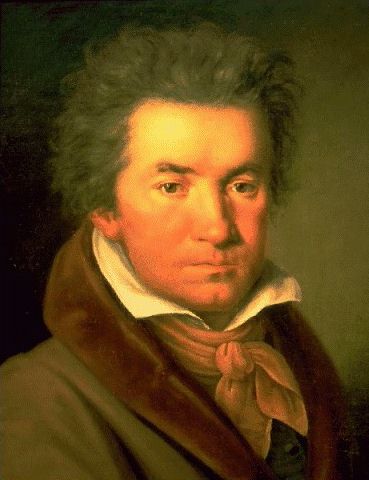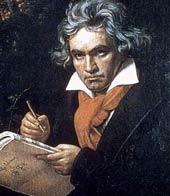The artist as a hero
Ludwig van Beethoven studied first with his father, Johann, a singer and instrumentalist in the service of the Elector of Cologne at Bonn, but mainly with C.G. Neefe, court organist. At 11 ½ he was able to deputize for Neefe; at 12 he had some music published. In 1787 he went to Vienna, but quickly returned on hearing that his mother was dying. Five years later he went back to Vienna, where he settled. He pursued his studies, first with Haydn, but there was some clash of temperaments and Beethoven studied too with Schenk, Albrechtsberger and Salieri.
 Until 1794 he was supported by the Elector at Bonn but he found patrons among the music-loving Viennese aristocracy and soon enjoyed success as a piano virtuoso, playing at private houses or palaces rather than in public. His public debut was in 1795; about the same time his first important publications appeared, three piano trios op.l and three piano sonatas op.2. As a pianist, it was reported, he had fire, brilliance and fantasy as well as depth of feeling. It is naturally in the piano sonatas, writing for his own instrument, that he is at his most original in this period; the Pathetique belongs to 1799, the Moonlight ('Sonata quasi una fantasia') to 1801, and these represent only the most obvious innovations in style and emotional content. These years also saw the composition of his first three piano concertos, his first two symphonies and a set of six string quartets op.l8.
Until 1794 he was supported by the Elector at Bonn but he found patrons among the music-loving Viennese aristocracy and soon enjoyed success as a piano virtuoso, playing at private houses or palaces rather than in public. His public debut was in 1795; about the same time his first important publications appeared, three piano trios op.l and three piano sonatas op.2. As a pianist, it was reported, he had fire, brilliance and fantasy as well as depth of feeling. It is naturally in the piano sonatas, writing for his own instrument, that he is at his most original in this period; the Pathetique belongs to 1799, the Moonlight ('Sonata quasi una fantasia') to 1801, and these represent only the most obvious innovations in style and emotional content. These years also saw the composition of his first three piano concertos, his first two symphonies and a set of six string quartets op.l8.
1802, however, was a year of crisis for Beethoven, with his realization that the impaired hearing he had noticed for some time was incurable and sure to worsen. That autumn, at a village outside Vienna, Heiligenstadt, he wrote a will-like document, addressed to his two brothers, describing his bitter unhappiness over his affliction in terms suggesting that he thought death was near. But he came through with his determination strengthened and entered a new creative phase, generally called his 'middle period'. It is characterized by a heroic tone, evident in the Eroica Symphony (no.3, originally to have been dedicated not to a noble patron but to Napoleon), in Symphony no.5, where the sombre mood of the c Minor first movement ('Fate knocking on the door') ultimately yields to a triumphant C Major finale with piccolo, trombones and percussion added to the orchestra, and in his opera Fidelio. Here the heroic theme is made explicit by the story, in which (in the post-French Revolution 'rescue opera' tradition) a wife saves her imprisoned husband from murder at the hands of his oppressive political enemy. The three string quartets of this period, op.59, are similarly heroic in scale: the first, lasting some 45 minutes, is conceived with great breadth, and it too embodies a sense of triumph as the intense f Minor Adagio gives way to a jubilant finale in the major embodying (at the request of the dedicatee, Count Razumovsky) a Russian folk melody.

|







